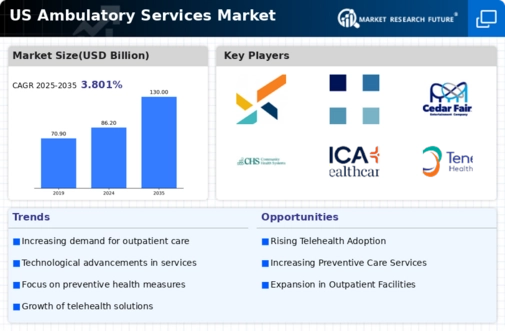Focus on Patient-Centered Care
The ambulatory services market is increasingly characterized by a focus on patient-centered care, which emphasizes the importance of tailoring healthcare services to meet individual patient needs. This approach fosters improved patient engagement and satisfaction, as providers prioritize communication and shared decision-making. Research indicates that patient-centered care can lead to better health outcomes and reduced hospital readmissions, which is particularly relevant in the context of chronic disease management. As healthcare organizations strive to enhance the patient experience, they are likely to invest in training and resources that support this model. This shift not only benefits patients but also positions providers competitively within the ambulatory services market.
Integration of Telehealth Services
The integration of telehealth services into the ambulatory services market represents a transformative shift in how healthcare is delivered. Telehealth facilitates remote consultations, allowing patients to access care from the comfort of their homes. This trend has gained traction due to its convenience and efficiency, particularly for follow-up appointments and chronic disease management. Data indicates that telehealth visits have surged, with estimates suggesting a 50% increase in usage among patients in the past year. As healthcare providers adopt telehealth solutions, they enhance their service offerings, thereby attracting a broader patient base. This integration not only improves access to care but also aligns with the evolving expectations of patients in the ambulatory services market.
Expansion of Specialty Care Services
The ambulatory services market is witnessing an expansion of specialty care services, driven by the increasing complexity of healthcare needs among patients. As chronic conditions become more prevalent, there is a growing demand for specialized outpatient services that address specific health issues. This trend is reflected in the establishment of dedicated ambulatory care centers that focus on areas such as orthopedics, cardiology, and oncology. Data suggests that specialty care visits have increased by approximately 25% over the past few years, highlighting the need for targeted services. By expanding specialty offerings, healthcare providers can enhance their service portfolio, attract new patients, and ultimately strengthen their position in the ambulatory services market.
Cost-Effectiveness of Ambulatory Care
Cost considerations play a pivotal role in the growth of the ambulatory services market. Patients and insurers alike are increasingly recognizing the financial benefits associated with outpatient care, which typically incurs lower costs compared to inpatient services. For instance, studies suggest that outpatient procedures can be up to 30% less expensive than their inpatient counterparts. This cost-effectiveness is appealing to both patients seeking affordable healthcare options and payers aiming to reduce overall healthcare expenditures. Consequently, healthcare systems are incentivized to expand their ambulatory service offerings, as they align with the broader goal of achieving value-based care. This trend not only enhances patient satisfaction but also positions providers favorably within the competitive landscape of the ambulatory services market.
Rising Demand for Outpatient Services
The ambulatory services market experiences a notable increase in demand for outpatient services, driven by a growing preference among patients for less invasive procedures. This shift is largely attributed to advancements in medical technology, which enable more complex treatments to be performed outside traditional hospital settings. According to recent data, outpatient visits account for approximately 70% of all healthcare encounters in the US, indicating a significant trend towards ambulatory care. This demand is further fueled by the aging population, which often requires ongoing management of chronic conditions. As a result, healthcare providers are increasingly investing in ambulatory services to meet patient needs, thereby enhancing their market presence and competitiveness in the ambulatory services market.






















Leave a Comment